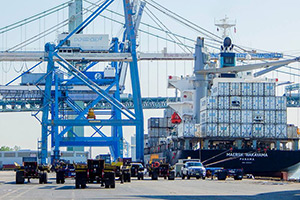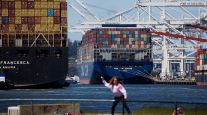Sedimental Journey: $300 Million for Deeper Delaware Means More Philadelphia Port Jobs

With 85% of the Delaware River navigation channel deepened to 45 feet, Pennsylvania elected officials gathered on the banks of the Delaware River on April 29 to celebrate.
Labor, business and government leaders came to Packer Avenue Marine Terminal in South Philadelphia to mark a milestone — the final $55 million in federal funding to deepen the river's 103-mile shipping channel that began in March 2013.
"Completing this project will mean more ships, more cargo, more commerce and more jobs," said Jerry Sweeney, chairman of the Philadelphia Regional Port Authority.
Deepening the channel from 40 feet to 45 feet will put ports on the Delaware in line with other major East Coast ports. "The largest U.S. ports already have deep water," Sweeney said.
The $300 million deepening, from Philadelphia to the Atlantic Ocean, should be completed by late 2017.
Sen. Robert Casey (D) told the crowd, "This is a project about the future and about jobs. This will be the most significant job creation potential of anything we could do in the region."
Deepening the channel was debated for nearly three decades, and U.S. Rep. Bob Brady (D), whose district includes much of the riverfront in Philadelphia and Delaware County, recalled the long journey.
Brady said the day after he was elected in 1998 he got a phone call from then-congressman Bob Borski, who said, "'You got to get down here. We're doing the dredging bill.'"
"Every year, we had to fight back amendments because they were trying to take the money out," Brady said. "We're here right now because it's going to get done."
Mayor Jim Kenney has been an enthusiastic supporter of expanding the Philadelphia port, including Packer Avenue terminal and 194 acres at the eastern end of the Navy Yard known as Southport.
"The port not only needs dredging, it also needs new equipment, new cranes, new warehousing, and available portside space," he said. "We want to continue to keep our break-bulk cargo, we want to improve our container traffic," he said.
Sweeney said that deepening the channel to 45 feet would generate more than $1 billion in port infrastructure investment projects "and help us remain competitive."
An example is the Southport marine terminal complex, he said, currently out to bid for development.
Gov. Tom Wolf (D) has said the number of potential jobs created from Southport will depend on the type of development.
If Southport is developed entirely as an energy terminal, he said, up to 590 jobs could be created. If the site is developed completely for a "nonenergy use," Wolf said, up to 3,720 potential jobs could be created.
PRPA, a state agency which owns the Southport land and plans to lease it, has asked six groups to submit financial and development plans by Aug. 31. Proposed uses include a marine terminal to handle container cargoes, an energy port and additional automobile-processing space. Thousands of Hyundai and Kia vehicles arrive here annually on ships from South Korea, headed to dealer showrooms.
Cargo volumes grew at the Philadelphia port in 2015 for the sixth consecutive year. Total tonnage surpassed 6 million tons, up 2.38% from 2014, the port authority said.
Port officials say a deeper river channel should put more cargo on ships coming into the ports and allow larger ships to sail the river after the Panama Canal expansion is completed this year.
Now, large ships have to be careful coming up the Delaware. Some transfer cargo onto smaller vessels, a process known as "lightering," before coming upriver.
With deeper water, Philadelphia could be a ship's first port of call, instead of second or later.
Ships are getting bigger, and the largest U.S. ports already have deeper water: Baltimore; Norfolk, Virginia.; and Oakland, California, are dredged to 50 feet. Charleston, South Carolina, is at 45 feet. Los Angeles soon will be deepened to 53 feet, and Long Beach, California, to 76 feet. The Port of New York and New Jersey is being deepened to 50 feet from 45.
The next steps for the deepening project include more rock blasting near Marcus Hook, which will begin in December. Dredging work at Broadkill Beach in Delaware has been completed, said Ed Voigt, public affairs chief for the Army Corps' Philadelphia District.
The next phase, deepening a stretch of river in the upper Delaware Bay, will begin later this year, Voigt said.
The last section to be dredged will be between Wilmington and Chester next year. "The channel should be open for business by the end of 2017 or early 2018 at the latest," Voigt said.


